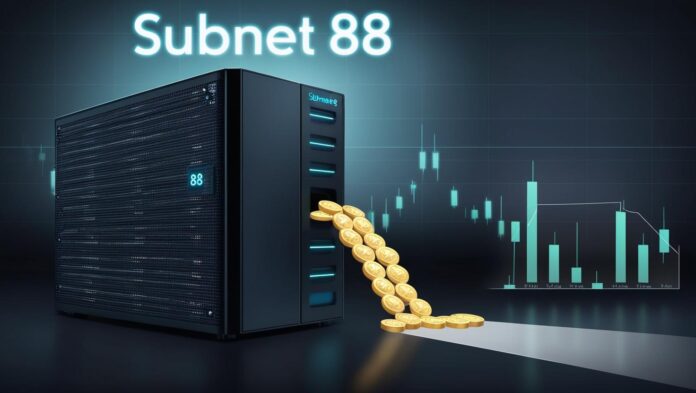There are subnets built on buzz, and then there are subnets like this one. Subnet 88—registered just weeks ago on April 7—is quietly paying out, quietly growing, and quietly making a name for itself. If you blinked, you might’ve missed the part where it started rewarding Root stakers with Alpha while its price dipped 19% in a single day. But in the world of Bittensor, where emissions and liquidity are the real signals, price alone rarely tells the full story.
Let’s start with what’s visible. The Alpha token for Subnet 88 is priced at 0.005465 TAO—just under two bucks at current conversion rates. That’s either bargain basement or floorless, depending on how you see it. The market cap sits at around $333K, with a fully diluted valuation of $41 million. There’s decent activity: over $237K in trading volume in 24 hours, though the chart also shows a -67% drop from yesterday’s highs. In crypto time, that’s an entire cycle.
But zoom in past the market chatter and what you’ll find is a surprisingly functional pool. The subnet has 212 TAO in liquidity and 38.87K Alpha tokens floating around, mostly untouched—99.46% of the Alpha is still sitting in the pool. This usually implies the emissions haven’t been heavily claimed or moved, which is often the case in subnets that are either early, misunderstood, or not yet retail-friendly.
For Root stakers, it’s been a quiet win. Subnet 88 is routing a chunk of its emissions back to the network’s validators. Anyone staking TAO to Root validators is receiving Alpha from this subnet without needing to buy in or time the market. It’s passive, slow, and—depending on the subnet’s emissions plan—possibly lucrative over time.
The bigger question is: what does Subnet 88 actually do?
That’s where it gets fuzzy. The short description promises “optimising staking strategies”—an ambition shared by many, defined by few. No front-facing dApp has been announced, and there’s no clear roadmap, GitHub repo, or working demo. But that hasn’t stopped traders from sniffing around. The volume-to-market cap ratio is over 71%, meaning there’s active interest. Whether it’s speculative farming or early conviction is still too early to tell.
What makes Subnet 88 interesting isn’t what it has done, but what it’s currently offering: live emissions, high APYs for early stakers, and ultra-low entry prices. That’s a cocktail that attracts both builders and opportunists—sometimes the same people. For a protocol that’s positioning itself as a “staking strategy optimiser,” it’s fitting that the first people making use of it are staking veterans looking for edge in the post-dTao era.
Still, the risks are real. TAO liquidity in the pool is just 0.54%, which means any serious buy or sell creates slippage. There’s no indication of token burns, fee capture, or revenue redirection to sustain Alpha’s value beyond emissions. And while the fully diluted supply implies long-term ambition, the current setup suggests it’s still in the experimental phase—heavy on narrative, light on product.
None of this is to say that Subnet 88 isn’t worth watching. Quite the opposite. In a network increasingly populated by AI inference tools, research hubs, and trading models, a staking strategy engine—if done right—might become a core primitive. Everyone wants better delegation tools, optimised APYs, and smarter capital flow. Whether this subnet builds that or not is unknown. But it’s emitting rewards now, and in this ecosystem, that’s often the first sign of life.
Subnet 88 might not be shouting, but it’s not silent either. Its emissions are working. Its chart has moved. And its token is circulating—however gently. That’s more than most new subnets can claim.
It’s staking. It’s early. And like most things in this space, it might just be chaos pretending to be a strategy.


